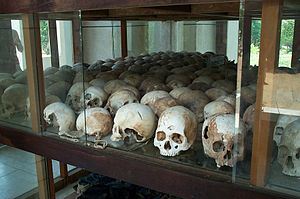Genocidi de Cambodja

| ||||
| Tipus | assassinat massiu autogenocide (en) | |||
|---|---|---|---|---|
| Interval de temps | 17 abril 1975 - 7 gener 1979 | |||
| Data | dècada del 1970 | |||
| Localització | Kamputxea Democràtica (Cambodja) | |||
| Estat | Cambodja | |||
| Participant | ||||
El Genocidi de Cambodja (llengua khmer: របបប្រល័យពូជសាសន៍នៅកម្ពុជា) fou la persecució i assassinat sistemàtics de ciutadans de Cambodja practicat pel règim dels Khmer Rouge sota el lideratge de Pol Pot, secretari general del Partit Comunista de Kamputxea entre el 1975 i el 1979. Va resultar en la morts d'1,5 a 2 milions de persones, gairebé una quarta de la població de Cambodja el 1975 (uns 7,8 milions).[1][2][3]
Referències
[modifica]- ↑ Heuveline, Patrick. «The Demographic Analysis of Mortality Crises: The Case of Cambodia, 1970–1979». A: Forced Migration and Mortality. National Academies Press, 2001, p. 102–105. ISBN 978-0-309-07334-9.
- ↑ Kiernan, Ben Critical Asian Studies, 35, 4, 2003, pàg. 585–597. DOI: 10.1080/1467271032000147041. «We may safely conclude, from known pre- and post-genocide population figures and from professional demographic calculations, that the 1975–79 death toll was between 1.671 and 1.871 million people, 21 to 24 percent of Cambodia's 1975 population.»
- ↑ Locard, Henri European Review of History, 12, 1, 3-2005, pàg. 121–143. DOI: 10.1080/13507480500047811. «Between 17 April 1975 and 7 January 1979 the death toll was about 25% of a population of some 7.8 million; 33.5% of men were massacred or died unnatural deaths as against 15.7% of the women, and 41.9% of the population of Phnom Penh. ... Since 1979, the so-called Pol Pot regime has been equated to Hitler and the Nazis. This is why the word 'genocide' (associated with Nazism) has been used for the first time in a distinctly Communist regime by the invading Vietnamese to distance themselves from a government they had overturned. This 'revisionism' was expressed in several ways. The Khmer Rouge were said to have killed 3.3 million, some 1.3 million more people than they had in fact killed. There was one abominable state prison, S–21, now the Tuol Sleng Genocide Museum. In fact, there were more than 150 on the same model, at least one per district. ... For the United States in particular, denouncing the crimes of the Khmer Rouge was not at the top of their agenda in the early 1980s. Instead, as in the case of Afghanistan, it was still at times vital to counter what was perceived as the expansionist policies of the Soviets. The USA prioritised its budding friendship with the Democratic Republic of China to counter the 'evil' influence of the USSR in Southeast Asia, acting through its client state, revolutionary Vietnam. All the ASEAN countries shared that vision. So it became vital, with the military and financial help of China, to revive and develop armed resistance to the Vietnamese troops, with the resurrected KR at its core. ... [France] was instrumental in forcing the Sihanoukists and the Republicans to form an obscene alliance with its former tormentors, the KR, under the name of the Coalition Government of Democratic Kampuchea (CGDK) in 1982. In so doing, the international community officially reintegrated some of the worst perpetrators of crimes against humanity into the world diplomatic sphere...»

